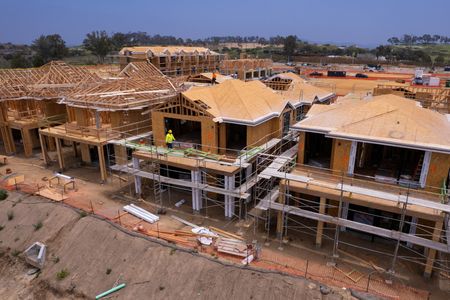By Lucia Mutikani
WASHINGTON (Reuters) – Permits for future U.S. single-family homebuilding jumped to a seven-month high in April, giving the struggling housing market a boost, but tightening credit conditions could make it difficult for builders to get finance for new projects.
The third straight monthly increase in single-family building permits, which was reported by the Commerce Department on Wednesday, reinforced the recent improvement in homebuilding sentiment. Still, major obstacles remain for the housing market, with the report also showing the pace of single-family home completions falling to a 15-month low, likely because of shortages of transformers and other building materials recently cited by builders.
“An increase in single-family permits and resilient homebuilder sentiment will support housing construction in the near-term, but we expect starts to lose momentum as the year progresses as tighter lending standards and weaker demand during a recession weigh on activity,” said Nancy Vanden Houten, U.S. lead economist at Oxford Economics in New York.
Single-family building permits rose 3.1% to a seasonally adjusted annual rate of 855,000 units last month, the highest level since last September. Permits in this largest segment of the housing market rose in all four regions.
A survey on Tuesday showed the National Association of Home Builders/Wells Fargo Housing Market index increased in May to the midpoint mark of 50 for the first time since July 2022 as a dearth of previously owned homes supported new construction.
Permits for housing projects with five units or more dropped 9.7% to a rate of 502,000 units, the lowest level since December 2020. The multi-family segment has been boosted by demand for rental housing. But the rental vacancy rate rose to a two-year high in the first quarter and stock of multi-family housing under construction is at a record high, limiting the scope for more new construction.
The plunge in multi-family approvals led overall building permits to fall 1.5% to a rate of 1.416 million units. Economists polled by Reuters had forecast permits would fall to a rate of 1.437 million units. The government revised the permits data going back to January 2017.
Stocks on Wall Street were trading higher. The dollar rose against a basket of currencies. U.S. Treasury prices were mixed.
MORTGAGE RATES RETREATING
The housing market has taken the biggest hit from the Federal Reserve’s fastest monetary policy tightening campaign since the 1980s.
The average rate on the popular 30-year fixed mortgage has dropped from a peak of 7.08% in November, which was the highest since 2002. It averaged 6.35% last week, according to data from mortgage finance agency Freddie Mac. That together with the tight supply of previously owned homes is pulling some buyers back into the market, allowing builders to break more ground.
Single-family housing starts climbed 1.6% to rate of 846,000 units last month. Data for March was revised down to show single-family homebuilding falling to a rate of 833,000 units instead of climbing to a pace of 861,000 units, as previously reported.
The government revised the starts data from January 2018 through March this year. Single-family housing starts plunged 28.1% on a year-on-year basis in April and remain well below their pace of at least one million units between July 2020 and June 2022.
Last month’s increase in single-family homebuilding was driven by a 59.5% surge in the West, which had been hampered by bad weather. Single-family starts fell in the Northeast, Midwest as well as the densely populated South.
“We are far from a booming rebound in the housing sector,” said Kathy Bostjancic, chief economist at Nationwide.
Starts for housing projects with five units or more increased 5.2% to a rate of 542,000 units.
With both single- and multi-family homebuilding rising, overall housing starts increased 2.2% to a rate of 1.401 million units in April. Economists had forecast starts would fall to a rate of 1.400 million units.
The number of houses approved for construction that are yet to be started fell 1.0% to 290,000 units, the lowest level since last June. The single-family homebuilding backlog jumped 4.5% to 139,000 units, while the completions rate for this segment fell 6.5% to a rate of 971,000 units, the lowest since January 2022.
The inventory of single-family housing under construction fell 1.4% to a rate of 698,000 units.
The stock of multi-family housing under construction increased 1.7% to an all-time high of 959,000 units.
“Given these weak numbers for new homes in the pipeline, and the extremely low level of existing homes for sale, the current weak state of the housing market looks to continue this year,” said Robert Frick, corporate economist at Navy Federal Credit Union in Vienna, Virginia.
(Reporting by Lucia Mutikani; Editing by Chizu Nomiyama, Daniel Wallis and Paul Simao)





